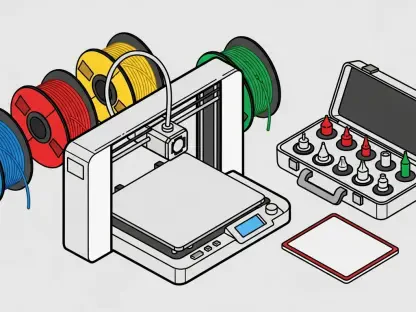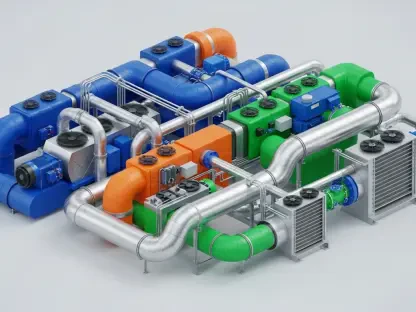Imagine a world where manufacturing achieves unparalleled efficiency, producing components that are not only lighter and stronger but also crafted with minimal waste, all thanks to the seamless integration of artificial intelligence and precision machining. This is the promise of the generative CNC market, a rapidly evolving sector that combines generative design tools with computer numerical control (CNC) machining to redefine modern production. Starting from a valuation of $1.5 billion in 2025, this industry is on track to skyrocket to $6.3 billion by 2035, propelled by a robust compound annual growth rate (CAGR) of 15.2%. This remarkable growth trajectory highlights the transformative potential of technology that enables engineers to explore countless design iterations in mere hours, optimizing for performance and sustainability. As industries ranging from aerospace to healthcare embrace this innovation, the impact on global manufacturing is becoming increasingly profound, setting the stage for a future where efficiency and ingenuity go hand in hand.
Forces Fueling Market Expansion
The ascent of the generative CNC market is driven by a confluence of technological advancements and pressing industry needs that demand smarter, more efficient production methods. A key factor is the growing appetite for lightweight, high-performance components in sectors like aerospace and automotive, where even a small reduction in weight can translate to significant cost savings and enhanced efficiency. For instance, aerospace companies are leveraging this technology to design aircraft parts that improve fuel economy, while automotive manufacturers craft components that boost vehicle performance and comply with stringent emission regulations. Additionally, the adoption of digital twin technology and simulation-driven processes allows for virtual testing of designs, slashing the time and expense of moving from concept to production. This convergence of innovation is positioning generative CNC as an indispensable tool for industries aiming to stay competitive in a fast-paced, ever-evolving landscape.
Another powerful driver behind this market’s growth is the urgent push for sustainability in manufacturing practices across the globe. Generative CNC technology excels at optimizing designs to use the minimal amount of material necessary without compromising strength or functionality, thereby reducing waste and energy consumption. The rise of hybrid manufacturing, which integrates additive processes like 3D printing with traditional CNC machining, further enhances design flexibility and operational efficiency. Moreover, the increasing accessibility of AI-driven design tools through cloud-based platforms is democratizing this technology, enabling even small and medium-sized enterprises to adopt cutting-edge solutions without the burden of hefty upfront costs. As environmental concerns continue to shape industrial strategies, the role of generative CNC in fostering sustainable production methods is becoming a pivotal reason for its widespread adoption and sustained market momentum.
Industry Applications and Global Reach
Among the myriad applications of generative CNC technology, the aerospace and automotive sectors stand out as frontrunners, driven by their relentless pursuit of lightweighting and performance optimization. In aerospace, intricately designed components such as brackets and structural elements achieve significant weight reductions, directly impacting operational costs and environmental footprints. Similarly, the automotive industry benefits by producing parts that enhance electric vehicle range and overall efficiency, aligning with global sustainability goals. Beyond these giants, the medical device field is emerging as a vital growth area, with the technology facilitating the creation of customized implants and surgical tools tailored to individual patient needs. This ability to deliver precision and personalization underscores the versatility of generative CNC, positioning it as a critical asset across diverse high-stakes industries hungry for innovation.
Geographically, the generative CNC market reveals distinct patterns of growth and adoption, with certain regions emerging as powerhouses of technological progress. North America currently holds the largest market share, bolstered by a robust aerospace sector and the presence of leading software providers like Autodesk and Siemens, which drive innovation in design and machining integration. Europe follows closely, with nations such as Germany and the UK embedding generative design into their smart manufacturing frameworks under Industry 4.0 initiatives. However, the Asia-Pacific region is identified as the fastest-growing market, fueled by rapid industrialization and significant investments in automotive and electronics manufacturing in countries like China, India, and Japan. This global disparity highlights how varying levels of industrial maturity and technological readiness shape the adoption of generative CNC, creating a dynamic landscape of opportunity and competition on an international scale.
Navigating Challenges and Competitive Dynamics
Despite its promising outlook, the generative CNC market grapples with significant hurdles that could temper its rapid expansion if left unaddressed. One of the most pressing challenges is the high cost associated with integrating generative design software with existing legacy systems, a barrier that often proves prohibitive for smaller manufacturers with constrained budgets. Additionally, there exists a notable shortage of skilled professionals adept in both generative design and CNC programming, which slows adoption rates in certain regions and sectors. Tackling these obstacles will require concerted efforts to develop more affordable, user-friendly solutions and to invest in comprehensive training programs that equip the workforce with the necessary expertise. Overcoming these barriers is essential to ensure that the benefits of this technology reach a broader spectrum of manufacturers, sustaining the market’s upward trajectory.
The competitive landscape of the generative CNC market is vibrant and multifaceted, characterized by a blend of established industry giants and agile innovators pushing the boundaries of what’s possible. Major players like Siemens and Dassault Systèmes dominate with their sophisticated generative design software and seamless CNC integration capabilities, setting high standards for performance and reliability. Meanwhile, emerging companies such as nTopology are gaining ground by focusing on next-generation design platforms that prioritize lightweighting and optimization, catering to niche but growing demands. Strategic moves, including acquisitions and partnerships, further intensify competition as firms seek to expand their technological prowess and market presence. This dynamic environment fosters continuous innovation, ensuring that advancements in generative CNC technology keep pace with the evolving needs of industries worldwide, ultimately benefiting end users through enhanced capabilities and solutions.
Shaping the Future of Manufacturing
Reflecting on the journey of the generative CNC market, it has become evident over recent years that its integration into mainstream manufacturing marked a pivotal shift in how industries approach design and production. The technology’s ability to merge AI-driven optimization with precision machining redefined efficiency, enabling the creation of components that were once deemed impossible. Industries like aerospace and automotive witnessed transformative changes, achieving unprecedented performance metrics, while smaller sectors like medical devices adapted to offer tailored solutions. This widespread impact underscored the market’s role as a catalyst for industrial evolution, driven by a relentless pursuit of innovation and sustainability that reshaped manufacturing norms.
Looking ahead, the path forward for the generative CNC market involves a strategic focus on overcoming existing limitations through targeted initiatives. Stakeholders should prioritize the development of cost-effective tools to make this technology accessible to a wider range of manufacturers, while educational efforts must ramp up to address the skills gap in the workforce. Collaboration between industry leaders and policymakers could further accelerate adoption by fostering an ecosystem that supports innovation and integration. As the market continues to evolve toward a projected valuation of $6.3 billion by 2035, these actionable steps will be crucial in ensuring that generative CNC not only meets but exceeds expectations, cementing its place as a cornerstone of future manufacturing advancements.









